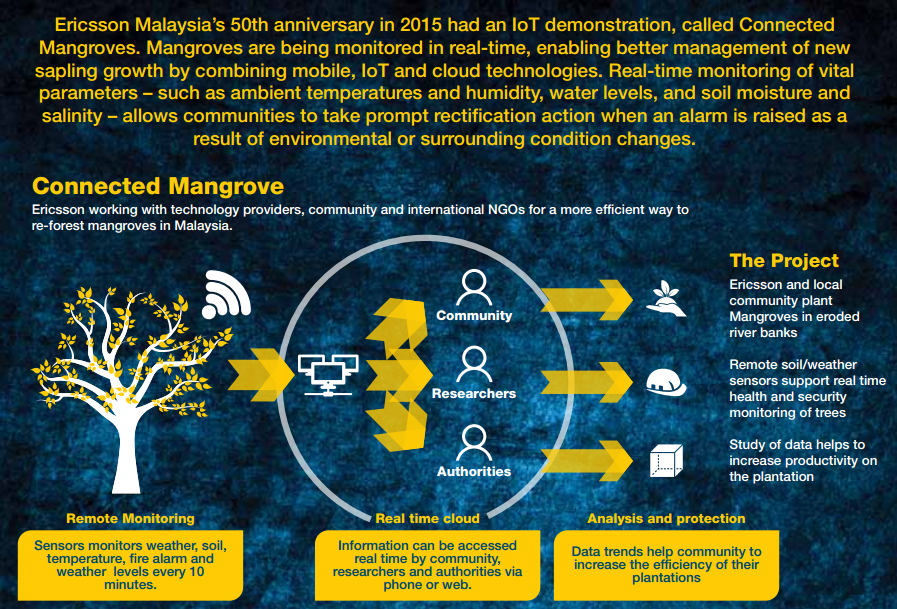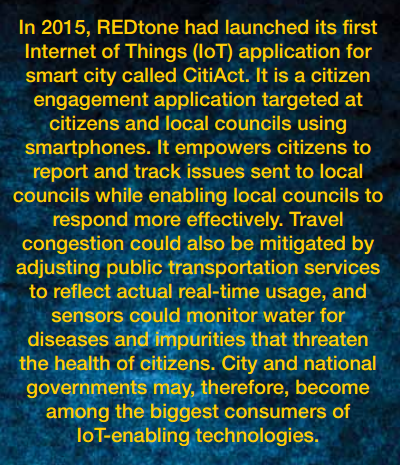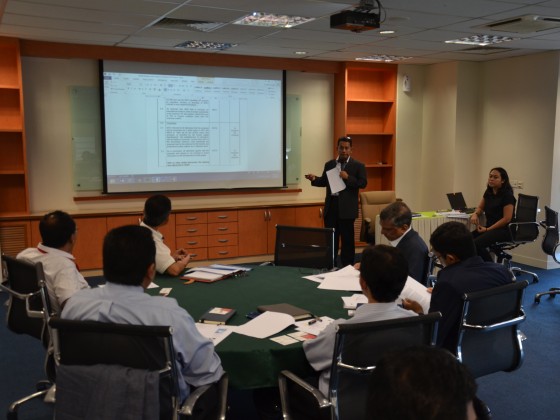by Mohd Hasan Mohd Saaid | Rushaizzad Abdul Rahim
Due in part to the expansion of global internet access and a reduction in the costs of digital technologies, the world is becoming an increasingly digitally connected space. It is estimated that, by 2017, the Internet will reach an excess of 4 billion users worldwide.
Over the past few years,the digital industry has been incrementally shifting toward the creation of an interconnected Internet of Things (IoT). IoT describes a web of wirelessly connected sensors and receivers that are able to communicate directly with not only humans, but also with any number of other devices. In broad term, IoT encompasses a wide array of devices ranging from wearable consumer fitness trackers to fully integrated power grids.
Even though IoT has not yet fully matured, IoT-enabling technologies is growing fast and, by 2020, up to 50 billion ‘things’ may be connected to the Internet. Although much of the attention given to IoT centres on how highly developed countries might utilize these innovations to improve existing technologies and provide new consumer products and services, emerging economies may benefit even more from IoT, helping to spur the movement toward a digitally connected world.
WHY IT MATTERS
The availability of modern communications technologies and growing broadband access has been shown to have a positive effect on accelerating the economic growth of both developed and developing countries. Simply put, countries with greater access to data are often better able to harness the wealth of information to improve the country’s infrastructure as well as its efficiency and financial bottom line. According to the report by McKinsey Global Institute in June 2015, nearly 40 percent of value could be generated in developing economies. From an economic standpoint, the development of emerging economies may open new markets for existing firms while fostering innovation and heightening competition. From a sustainability perspective, IoT in developing countries may not only encourage economic growth, but also improve the quality of life by monitoring and improving agricultural yields, tracking air quality, and providing improved access to clean water

DRIVERS
- Improved data management – As organizations increasingly quantify their operations, the need to harness andinterpret large data streams grows in importance. Leveraging the value of this data requires an efficient and effective web of machines which are ableto help analyse masses of data.
- Demand for efficient systems – Emerging economies may be forced to do more with fewer resources. Demand inthe developing world for precise and efficient tools that accurately monitor production, consumption and waste is, therefore, increasing.
- A growing global middle class – The population and purchasing power of the middle class in many developing countries is rapidly on the rise. By 2030, it is estimated that 80% of middle class purchasing power growth will come from countries currently categorised as developing economies.
- Environmental sustainability – Pressure by international regulatory bodies, such as the United Nations, to simultaneously develop an industrial

OPPORTUNITIES
- The growing need forthe IoT in the developing world will likely open up investment and partnership opportunities between local tech companies, distribution channels, and multinationals that produce IoT-enabling technologies, including remote sensors, RFID, processors, short and long-range communication systems, energy harvesting technologies, battery technologies, and software.
- The ITU/Cisco report points to evidence of IoT already having an important impact on health, education and livelihood programmes (such as agricultural productivity) in developing countries.
- IoT devices are already common, cheap and easily replaceable in developing markets. Basic infrastructure to support IoT (Wi-Fi, Internet cafés, etc.) is already in place in many developing communities, with near-ubiquitous basic mobile connectivity (95% global 2G coverage, according to ITU’s latest statistics) and growing levels of 3G coverage (89% of the world’s urban dwellers – but only 29% of rural inhabitants).
- Cities in the developing world will become smarter to accommodate the growing needs of urbanization and the rapid urban growth characteristic of these regions. This will allow governments to become increasingly efficient at performing infrastructure maintenance. For example, continuous sensory readings would allow cities to target specific areas in need of repair through realtime data rather than an arbitrary schedule.
- Steady expansion of the IoT in developing markets could greatly increase the efficiency of businesses in these economies. Multinational firms may find themselves increasingly able to utilize the IoT to provide a constant stream of data on the performance of their branches and subsidiaries around the globe. Additionally, agricultural enterprises may reduce waste and costs by using soil monitors to more accurately target areas which need water and fertilizer.
- A recent report from ITU and Cisco has identified the Internet of Things (IoT) as a major global development opportunity that has the potential to improve the lives of millions and accelerate progress towards the UN Sustainable Development Goals.
- Expansion of IoT could greatly enhance the granularity of retailers’ understanding of consumer behaviour. This data will provide growing insight into the distinctive behaviours and preferences among consumers in various developing markets. IoT can be used to track the path of purchases, monitoring how consumers navigate stores and what products they consider prior to making a buying decision. Just as retailers in developed economies have used these technologies to manage consumer data, those in developing markets could use the insights gleaned to improve customer service, provide consumers with a greater degree of personalization and convenience.
- The application of Internetenabled sensors allows for constant monitoring of the condition and performance of any number of products. In developing markets, just as in developed ones, this would allow field service technicians to improve their level of service by efficiently and proactively performing repairs, rather than merely providing reactionary maintenance. Data analytics would be used to predict component failure to help manufacturers reduce costs and the potential for systems to be offline for repairs.
- Companies that embrace flexibility and can adjust quickly to an everchanging flow of real-time information would achieve the greatest success in the rapid-decision-making environment enabled, and necessitated, by the expansion of the IoT in developing markets. oBstAcLesAnd risks
- For the IoT to reach its potential, wireless broadband signals need to be widely available. Strict governmental regulation of communication technologies may therefore limit the commercial success of the IoT in some countries.
- A shortfall of private investment could complicate or delay the growth of IoT in the developing world.
- A 2015 Microsoft poll of consumers in seven developing countries (the BRICs. Indonesia, South Africa, and Turkey) suggests that privacy concerns in these markets would likely be as high, or higher, than those in developed economies. Except India, the majority of consumers in all of these nations believe that technology’s effect on privacy has been ‘mostly negative’. Companies
looking to collect or transmit consumer data in these markets should therefore be prepared to address these concerns openly. - Ideally, policies must work in tandem with private funding to accelerate nearterm technologies to market and support promising long-term projects under a stable structure. To achieve that goal, policy makers must develop a better understanding of the technologies’ risks and opportunities to create regulatory environments that promote targeted funding and realistic commercialization timelines.
References
1. David Bolton, Developing Countries ‘Will Drive the Development of the Internet of Things,’ December 2 2015, www.arc.applause.com.
2. Edward Kerschner & Naemma Huq. ‘Asian Affluence: The Emerging 21st Century Middle Class,’ June 2011, Morgan Stanley, www.morganstanleyfa.com.
3. ‘IoT Use Cases,’ 2015, www.ptc.com.
4. Mark Penn, ‘Views from Around the Globe: 2nd Annual Poll on How Personal Technology is Changing Our Lives,’ 2015, Microsoft, www.blogs.microsoft.com.
5. ‘Measuring the Information Society Report,’ 2015, International Telecommunications Union, www.itu.int.
6. Nye Longman, ‘Opinion: The Future of the Telecommunications Industry,’ February 4 2016, African Business Review, www.africanbuisinessreview.co.za.
7. Pilar Lagos, ‘How to Prepare for the Next Billion Users Before 2017,’ December 2, 2015. Unicef, www.unicefstories.com.
8. ‘The Internet of Things and Field Service Management,’ Aberdeen Group, www.aberdeen.com.
9. ‘Will the Internet of Things be Beneficial to the Environment,’ January 27 2016, www.cloudtweaks.com.
10. ‘REDtone optimistic on Internet of Things’, August 5 2015, http://www.thesundaily.my/news/1510005.
11. ‘IoT a connectivity key for developing world’, May 12 2016, http://www.gadget.co.za/iot-a-connectivity-key-for-developingworld/.
12. “The Internet of Things: Mapping the Value Beyond the Hype”, McKinsey Global Institute, June 2015



